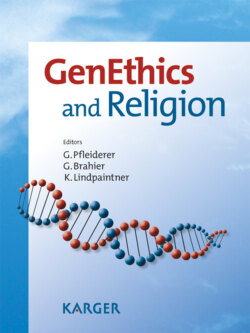Читать книгу GenEthics and Religion - Группа авторов - Страница 9
Foundations: Hermeneutic and Conceptional Reflections
ОглавлениеEthical evaluations should start with hermeneutical reflections, particularly if the genome is the object of interpretation. This is at least the suggestion of Christoph Rehmann-Sutter. The operative function of the genome for the organism is both a biological and a descriptive problem. The respective terminology, used not only by journalists but also by scientists, is full of metaphors. Textual metaphors are most common: genes are described as texts, instructions, messages, blueprints or programs. The textual imagery, however, seems to be misleading: the genome is not an author-subject, neither is it – as at least some of these metaphors suggest – strictly prescriptive or deterministic. Thus, Rehmann-Sutter pleads for a shift towards a new metaphor: systems. A systems approach to genomics opens the way for new images: DNA as a big library that can be used in many different ways and whose content depends on the context of use; or the multifunctionality of genes being compared to words that have different meanings. He argues that the transition from program genomics to systems genomics has implications for central topics of bioethics like genetic testing and counseling, or the moral perception of human embryos.
Critical reflection must also be used regarding the normative concepts of genethics. One of the most frequently used normative concepts is human dignity. The concept suggests an absolute, intrinsic, and ontological value of human beings and their nature. Opponents argue that this is a classical proof of naturalistic fallacy or of an overabundance of normative rhetoric. In order to avoid both, James Childress proposes a clear analysis of the concept. He distinguishes between (1) human dignity as a standard of rights and duties, and (2) human dignity as a standard of virtue. The first concept often goes along with the Kantian prohibition of instrumentalization. While the first would refer more to the person as the object of a gene-technological manipulation or treatment, the second is more focused on the character – the virtues or vices – of the users or providers of human engineering.
Although Childress himself favors a reflected and cautious use of the first understanding of the concept, he highlights at least to two problems: what is the added value of the concept compared, e.g., with more rational concepts such as autonomy? And how does the concept work as a normative ethical instrument in answering concrete bioethical questions? For instance: it is hard to make the case that human reproductive cloning necessarily involves the kind of instrumentalization that human dignity excludes. Human reproductive cloning does not necessarily involve treating offspring merely as means or instruments to other ends. The argument shows that it seems to be difficult to concentrate on the perspective of the object-person.
Concerning the virtue-concept Childress refers strongly to Leon Kass and the (US) President's Council on Bioethics (during the Bush Administration, suspended in 2009 by President Obama). In Kass’ concept human dignity and its violation is based on a fundamentally human pre-reflective moral wisdom of repugnance. Examples of wise repugnance include bestiality, cannibalism, mutilation of a corpse, and raping or murdering another human being. Repugnance is sufficient to condemn these actions; without rational justification, the repugnance at human cloning belongs in this category. In this understanding human dignity seems to work as a fundamental moral taboo, referring to a religious dimension of morality. This concept of human dignity is therefore suspected to smuggle in religious and theological concepts without having to acknowledge them as such. As similar observations could be made in the field of ethical debates on human genetic enhancement, Childress pleads for a public precautionary process in which society's basic values and the public's reflective preferences are carefully debated and idiomatic manipulations minimized.
